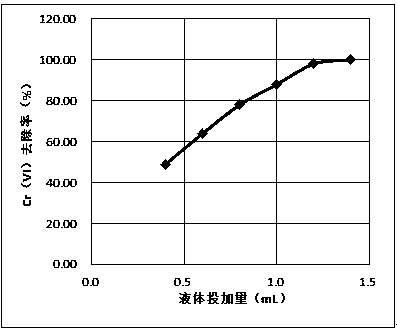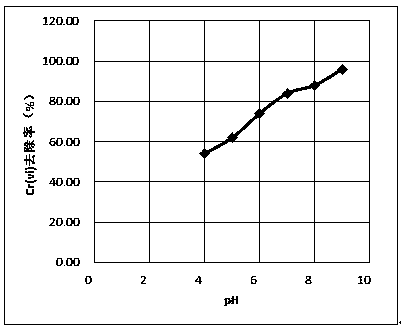Preparation method and application of anionic-based metal capture agent
An anion, base metal technology, applied in chemical instruments and methods, water pollutants, flocculation/sedimentation water/sewage treatment, etc., can solve the problem that flocculants cannot achieve good removal effect.
- Summary
- Abstract
- Description
- Claims
- Application Information
AI Technical Summary
Problems solved by technology
Method used
Image
Examples
Embodiment 1
[0027] Embodiment 1: a kind of preparation method of anion-based metal scavenger, comprises the steps:
[0028] S1: Prepare an anionic solution with a concentration of 1g / L, put anionic polyacrylamide into deionized water and stir well until the anionic polyacrylamide is completely dissolved;
[0029] S2: Take the anionic polyacrylamide solution from step S1, and add 3mol / L sodium hydroxide solution and carbon disulfide solution to obtain a mixed solution at the same time, the volume ratio of the anionic polyacrylamide solution: sodium hydroxide solution: carbon disulfide solution is 1:0.7-1.2:0.1-0.3; specifically, the volume ratio of anionic polyacrylamide solution: sodium hydroxide solution: carbon disulfide solution can be 1:0.7:0.1, 1:0.9:0.15, 1:1:0.2 or 1:1.2:0.3; Among them, the carbon disulfide solution is commercially available, and its concentration is a conventional concentration;
[0030] S3: Add deionized water to the mixed solution in step S2 to make up the vol...
Embodiment 2
[0037] Embodiment 2: the application of a kind of anion-based metal scavenger, the anion-based metal scavenger prepared in embodiment 1 is used to reduce the heavy metal in heavy metal ion wastewater, wherein the addition amount of anion-based metal scavenger and metal ion wastewater The volume ratio is 0.4-1.4:200, the initial heavy metal concentration is 5 mg / l; the pH value of the heavy metal ion wastewater is 6-9.
[0038] When the anion-based metal scavenger directly acts on the heavy metal ion wastewater, it cannot directly produce flocculation, but reduces the metal ions, which essentially removes the heavy metal ions in the wastewater.
[0039] The effect of the dosage of anion-based metal scavenger on the performance of removing metal chromium, see figure 2 :
[0040] pass figure 2 It can be seen that under the same pH value of heavy metal ion wastewater, when the dosage of anion-based metal scavenger increases, the removal rate of metal chromium in heavy metal io...
Embodiment 3
[0043] Embodiment 3: the application of a kind of anion-based metal scavenger, the anion-based metal scavenger prepared in embodiment 1 is first added in the heavy metal ion wastewater, carries out reduction reaction, when the pH value of heavy metal ion wastewater is at 6-7 In between, usually add inorganic coagulant after 45min-60min; the inorganic coagulant can be polyaluminum chloride, aluminum sulfate, alum, ferrous sulfate, ferric chloride or polyferric sulfate one or more.
[0044] The initial concentration of the heavy metal is 5mg / l, and the volume of the heavy metal ion wastewater is 200ml. The ratio of the volume of anion-based metal scavenger, the dosage of inorganic coagulant and the concentration of heavy metal ions is 0.4 ml: 28 mg / l: 1 mg / l.
[0045] The influence of different pH values on the removal rate is shown in Table 4:
[0046] pH
[0047] It can be seen from Table 4 that white flocs are produced only when the pH value is between 6-7, and ...
PUM
 Login to View More
Login to View More Abstract
Description
Claims
Application Information
 Login to View More
Login to View More - R&D
- Intellectual Property
- Life Sciences
- Materials
- Tech Scout
- Unparalleled Data Quality
- Higher Quality Content
- 60% Fewer Hallucinations
Browse by: Latest US Patents, China's latest patents, Technical Efficacy Thesaurus, Application Domain, Technology Topic, Popular Technical Reports.
© 2025 PatSnap. All rights reserved.Legal|Privacy policy|Modern Slavery Act Transparency Statement|Sitemap|About US| Contact US: help@patsnap.com



